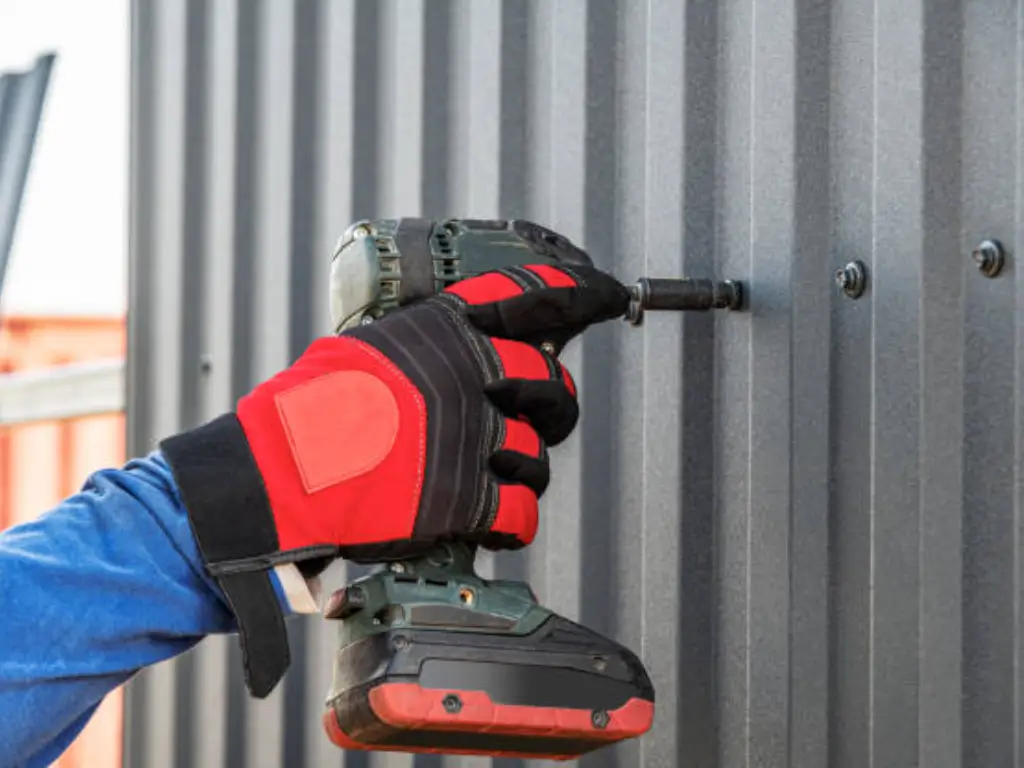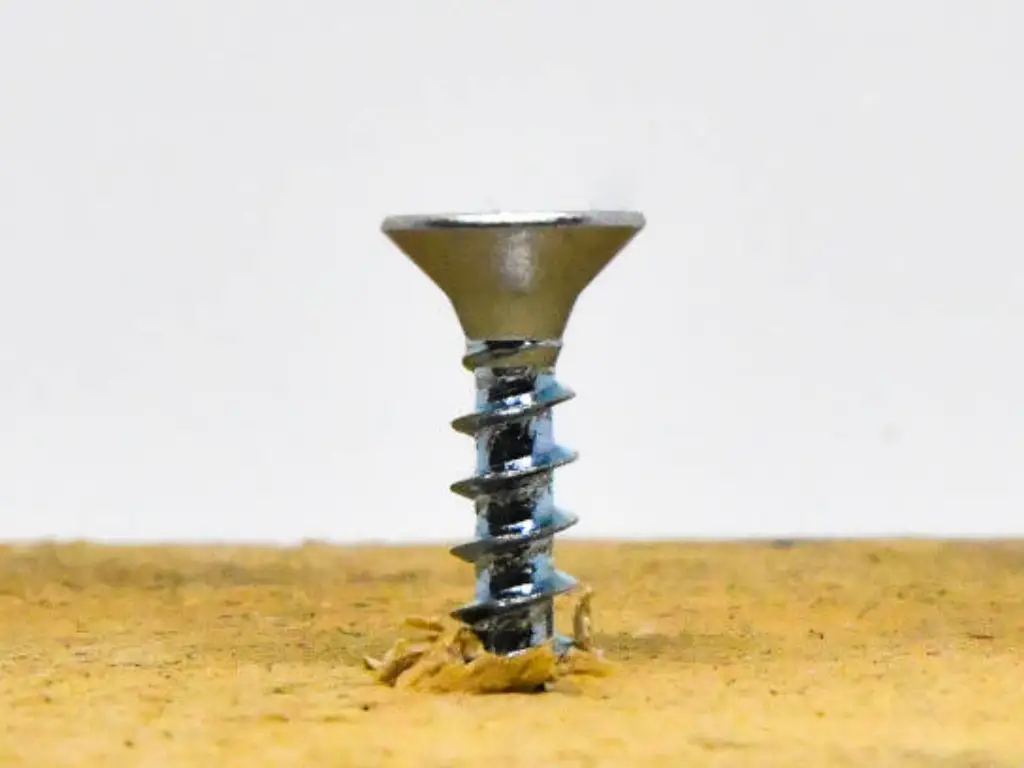What is A Sheet Metal Screw?
Sheet metal screws, though sounding strictly for industrial use, are actually a staple in various DIY and construction projects, available at any hardware store. They’re designed to fasten two pieces of metal together, utilizing their full-thread design to tap into a metal base with ease. Typically crafted from durable materials such as stainless steel or hardened steel, these screws come in various head types, including the commonly used pan head or flat head, to suit a wide range of applications. The defining feature of sheet metal screws? Their threads cover the screw’s shank entirely, optimizing them for securing metal pieces with a greater level of strength.

But do these characteristics render them unsuitable for other materials, especially wood? The prevailing thought might lean towards no, but that’s not necessarily the case. With their robust build and self-tapping nature, sheet metal screws show promising versatility beyond mere metal-to-metal applications, igniting interest among woodworking professionals and hobbyists alike.
What is A Wood Screw?
Transitioning from metal fasteners to the domain of timber, wood screws stand as the preferred fastener for projects involving wood materials. These screws are specifically designed with wood in mind, featuring a sharp point and a tapered body complemented by a coarse thread to securely grip and unite pieces of wood. Differing from sheet metal screws, wood screws usually have an unthreaded shank beneath the head, allowing for a tighter, flush finish against the joined wood surfaces.
Additionally, wood screws come in different types of screws head, such as the versatile flat head or decorative bugle head, each chosen based on the desired finish or aesthetic of the project. The material choices for wood screws range widely from brass to stainless steel screws, depending on the requirement for durability and visual appeal. With their wood-centric design, it’s evident they’re engineered for tasks involving lumber, plywood, or similar wood materials. Yet, does this specificity exclude the possibility of metal screws stepping up in wood applications?
Differences Between Wood Screws and Metal Screws
When debating sheet metal screws vs. wood screws, their distinctions extend beyond mere intended material use—metal vs. wood—and delve into their construction. Sheet metal screws boast a finer, sharper thread designed to seamlessly penetrate metal materials and secure a tight fit with minimal manual effort. In contrast, wood screws feature a coarser thread optimal for embedding into the fibrous texture of wood, ensuring a solid hold.
What’s more, wood screws are fine-tuned to pierce wood without risking its splitting, a crucial aspect for maintaining the structural integrity of woodworking projects. Meanwhile, the self-tapping functionality of sheet metal screws, especially notable in types equipped with a Tek drill bit end, showcases their capability to breach tougher bases without necessitating a pilot hole. This fundamental difference in design principles underscores the necessity of choosing the appropriate screw type for specific applications, ensuring optimal project outcomes.
| Feature | Wood Screws | Metal Screws |
| Target Material | Wood | Metal |
| Thread Design | Coarse for grip | Sharper, finer for cutting |
| Point Design | Prevents splitting wood | Self-tapping |
| Shank Design | Unthreaded shank for smooth join | Fully threaded for metal fastening |
| Application | Tight hold in wood | Strong in metal, usable in wood |
| Pre-Drilling | Recommended | Optional, but beneficial for wood |
Can You Use Sheet Metal Screws in Wood?
Addressing the pivotal query: can sheet metal screws be used in wood? The response is affirmative, yet with caveats. Although lacking the coarse thread of their wood counterparts, the incisive threads and heft of sheet metal screws permit them to latch onto wood with surprising efficacy.
However, swapping out all wood screws for sheet metal varieties isn’t advised without considering certain facets. Sheet metal screws’ shallower thread depth might not anchor as firmly in wood, particularly within softer varieties or in applications demanding substantial hold. Nevertheless, for lighter endeavors or makeshift solutions, sheet metal screws emerge as a viable, readily accessible alternative.
How to Securely Insert Sheet Metal Screws in Wood?
Ensuring a secure fit when using sheet metal screws in wood involves a bit of prep. First, definitely consider drilling a pilot hole. Though sheet metal screws are self-tapping, a pilot hole slightly smaller than the diameter of the screw makes for easier insertion and reduces the risk of splitting the wood. Use a drill bit that matches the inner diameter of the screw threads for the best fit.
Secondly, it might not hurt to use a bit of lubrication on the screw. A dab of soap or wax can help decrease the resistance when driving the screw in, making the process smoother and quicker. When tightening, be cautious not to overdo it. Sheet metal screws in wood might not withstand the same torque as in metal, and stripping the hole is a real possibility if you’re not careful. So, gentle does it – drive the screw in until it’s snug, but not overtightened.
Material Matters: Best Wood Types for Sheet Metal Screws
Not all woods are created equal, especially when it comes to using sheet metal screws. Hardwoods like oak or maple, with their dense and strong nature, can handle sheet metal screws better than softer woods such as pine or cedar. The denser the wood, the greater the grip the screw threads can achieve, leading to a sturdier hold. However, the very strength of hardwoods means pre-drilling becomes even more crucial to avoid stripping the screw or damaging the wood.

For applications where the wood’s structural integrity is paramount, it may be better to stick with wood screws. Yet, for less critical projects or when experimenting, the ability of sheet metal screws to fasten effectively in various types of wood opens up a plethora of possibilities. Whether it’s a quick repair or a temporary setup, choosing the right wood for your project can make all the difference.
Preparation Tips: Drilling Pilot Holes for Sheet Metal Screws in Wood
Drilling a pilot hole for sheet metal screws in wood is not just about making the insertion easier; it’s also about safeguarding the wood from damage. The ideal pilot hole should be slightly smaller than the screw’s diameter, allowing the screw to cut into the wood and establish a snug fit. To determine the right size drill bit, hold it against the screw; the bit should match the screw’s core diameter, ignoring the threads.
Remember, the depth of the pilot hole is equally important. It should be as deep as the screw will go to ensure smooth insertion all the way. For an added layer of precision, mark the desired depth on the drill bit with a piece of tape as a visual guide. This preparation step, though seemingly minor, plays a significant role in the success of using sheet metal screws in wood, ensuring a secure and stable fastening.
Safety First: Ensuring Stability with Sheet Metal Screws in Wood Projects
When venturing to use sheet metal screws in woodworking projects, safety and stability should be top of mind. While these screws can provide a strong hold in many scenarios, understanding their limitations is key. For projects bearing heavy loads or requiring long-term durability, the greater level of strength offered by traditional wood screws or wood to metal screws might be necessary.
Additionally, selecting the appropriate screw length and diameter is crucial for stability. A screw that’s too short may not provide enough grip, while one that’s too long could protrude awkwardly or even weaken the wood by dividing it. Always aim for a size that allows the screw to anchor securely without compromising the wood’s structural integrity. It’s this careful consideration and proper planning that ensure the safety and success of your wood projects, regardless of the fastening materials used.
Avoiding Common Mistakes When Using Sheet Metal Screws in Wood
Embracing sheet metal screws for wood applications can be a game-changer, but it’s not without its pitfalls. A common blunder is neglecting to drill pilot holes, which not only makes the job harder but also increases the risk of the wood splitting. Don’t underestimate the importance of this simple prep step. Another oversight is choosing the wrong screw size – both in terms of length and diameter. This can lead to insufficient grip or, worse, damage to your wood pieces.
Over-tightening is another mistake to watch out for. It’s tempting to crank down on the screw to ensure it’s secure, but with sheet metal screws, this might strip the wood, leaving you with a loose and unreliable connection. Remember, it’s about finding that sweet spot where the screw is snug but not overstrained. Avoid these common errors, and incorporating sheet metal screws into your wood projects can be a smooth and effective process.
Finishing Touches: Covering and Painting
After successfully inserting sheet metal screws into wood, giving your project a clean finish is the next step. If the screw heads are protruding and you’d prefer a flush surface, consider using a countersink bit before driving the screws. This can help the heads sit neatly within the wood surface. As for aesthetics, especially for projects where the final appearance is crucial, covering the screw heads with wood filler provides a smooth canvas ready for painting or staining.

When painting, ensure any filler used is completely dry and sanded down to match the wood’s surface level. Applying a primer can also help achieve a more uniform and durable finish. Whether you’re aiming for a natural wood look or a vibrant color scheme, these final touches can significantly enhance the overall appearance and longevity of your project, making your use of sheet metal screws in wood not just practical but visually pleasing too.
Conclusion
The versatility of sheet metal screws allows for their use in wood applications, despite their metal-centric design. Whether it’s for a quick fix or a unique project, understanding the how-tos and caveats ensures successful outcomes. Remember, the key lies in careful preparation, choosing the right materials, and avoiding common mistakes. With a little creativity and adherence to best practices, combining sheet metal screws with wood materials can offer innovative solutions to everyday construction dilemmas, expanding the horizons of what’s possible in woodworking and beyond.






